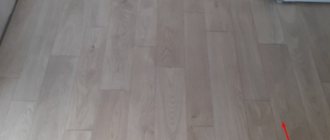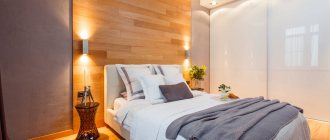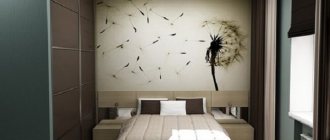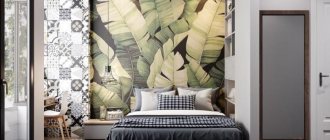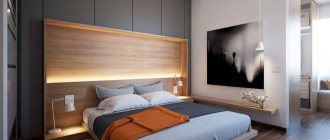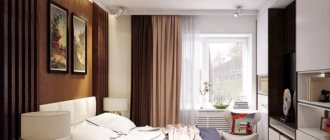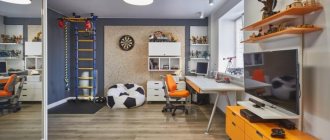A modern bedroom with laminate flooring on the wall looks great and stylish. This original design solution is suitable for decorating rooms in any style, thanks to the variety of patterns and textures of this universal finishing material.
Wall surfaces finished with laminate imitating wood, stone, brick, marble make the interior more comfortable and attractive. In addition, decorating walls and floors with one type of finish visually expands the space. Therefore, this technique is ideal for small bedrooms.
Choosing a laminate for wall decoration
When choosing wall laminate for the bedroom, you should pay special attention to its appearance, wear resistance class and fastening system.
A wall decorated with laminate should look attractive, be in harmony with other types of decoration and fit perfectly into the overall design of the room. To a large extent it depends on the appearance of the finishing material.
It is better to choose a laminate with embossing and patterns that will match the style of the floor, wallpaper or plaster on the walls, and wooden furniture elements.
The choice of shade depends on the design idea. The color of laminate on the wall can be combined with flooring, furniture, wallpaper and textiles. Or it can contrast with the general background of the interior if used to decorate an accent wall at the head of the bed.
The degree of wear resistance of the laminate may not be too high. After all, there is practically no load on this material on the walls.
The type of fastening system depends on the quality of the surfaces being finished. For smooth walls, adhesive laminate is perfect. But for problem walls it is better to use material with tongue and groove or click locks. When finishing uneven walls with laminate, you will have to carry out some preparatory work.
First, let's decide how we will attach the laminate to the wall.
Types of laminate surfaces in an apartment
The aesthetics of appearance is important: the house is filled with coziness, comfort, furniture is purchased for the flooring. Focus on the style and design of your living space and budget. There are several types:
- standard – characterized by a slight silky shine, small indentations (imitation of wood pores), found in all manufacturers;
- textured surface - small relief, wood-type fibers, prominent pores, large pattern under the texture of wood;
- embossed – a pronounced relief, it is smooth and clear, the lines are longitudinal;
- country – the relief is made using hand-processed wood;
- wood under oil is a beautiful imitation of wood coating, with a smooth matte surface, no pores.
Choosing laminate flooring is an opportunity to individually and original decorate the interior of your apartment.
The latter option is called oil-absorbed wood. Photos of the types of laminate on the floors and walls in the apartment can be found on design websites.
Standard surface
Wood (aged wood)
This type is distinguished by a large and smooth relief, exactly imitating the texture of wood that has chips. The effect can be created by leaving the boards outdoors for a long time. The board will be exposed to moisture, wind, and light. Next, it is cleaned with a metal scraper and polished. Covered with paint and oil.
Consumers have a wide choice of more than one hundred types of products.
Gloss
The wood is varnished with a shiny sheen. Often manufacturers use two technologies in one: glossy and silky-glossy look.
Recommended for use at home.
Wax
Beautiful imitation of wood treated with wax. The surface is perfectly flat, clean, smooth. There are small ripples, no pores, the reflection is soft and warm.
It is the most optimal and popular option.
Natural structure
A clear imitation of natural wood coated with paint and varnish. The board is smooth, without nicks, has a silky shine, the pattern repeats the grain of the wood.
Today, such products are increasingly used at home.
Options for attaching laminate to the wall
There are different ways to attach laminate to the wall, the choice of which depends on the size and shape of the bedroom.
Horizontal mounting is best used in small rooms with low ceilings. The laminate should be laid in a checkerboard or cascade pattern so that the joints of the boards are less noticeable. In low rooms it is worth using such finishing in the form of panels that do not reach the junction of the wall and ceiling. By fixing the laminate to the wall in this way, you can visually expand the space and raise the ceiling.
The vertical installation method is also good for low bedrooms. But in narrow rooms it is better not to use it, since vertical stripes will stretch the room even more. This type of installation is perfect for covering the entire surface of the wall.
Diagonal mounting of laminate on the wall can be used in bedrooms of any size. Surfaces finished in this way look original and stylish. This is the best solution for decorating an accent wall.
This type of laminate installation is the most labor-intensive, requiring perfect fit of the cuts. It should also be taken into account that the consumption of finishing material in this case will be greater than with horizontal and vertical installation.
Design options
The choice of laminate colors is huge. These are many shades of natural wood, colored panels, imitation parquet, stone or tiles.
Kitchens made from well-combined materials can be zoned, the furniture can be highlighted favorably, and effective contrasts can be created.
White
A white laminate apron in the kitchen interior matches any furniture. Such panels can be used to decorate entire walls or individual areas. The room will look brighter and fresher, the space will visually expand.
White walls go well with wood furniture in light warm tones. This can be used to create a classic setting or a Scandinavian style.
Black
Laminate of this color is usually used in high-tech style, which is more popular with young people. This option is good for spacious and well-lit kitchens. In a small and dark space the atmosphere will be too gloomy.
Black panels are best used to decorate only one wall or inserts on a lighter background. In this case, it is better to make the ceiling contrastingly light. Furniture should not blend with a black background, but you can make a few accents to match it.
In a large room, you can make the furniture and walls black, then the floor, ceiling and countertops should be light. This contrast looks very stylish, but requires good lighting in the room. It's better if it's natural light.
Grey
Laminate of this color must be handled carefully, otherwise the room will become too impersonal. Gray wall decoration sets off bright furniture well. It can be blue, cold blue.
You can combine gray walls with yellow, red, orange, purple furniture, but choose the shades wisely. The furniture should not be all bright colors, but only its individual elements or the upper part. Countertops should be neutral tones.
Yellow, red, green
More often you can find laminate in various shades of natural wood, but there are also panels of bright and rich colors. It is better not to decorate entire walls with them, but to use them for zoning.
A colored apron goes well with furniture in neutral tones. In the dining area or relaxation area, you can create a composite finish using colored panels and slats in soothing shades.
Necessary tools and preparatory work
Installing laminate flooring on a wall yourself requires preparatory work. But first you should stock up on special tools that will greatly facilitate this process.
So, to install laminate you will need:
- drill, pobedit drills, self-tapping screws;
- electric jigsaw or wood saw;
- screwdriver or screwdriver;
- wooden hammer;
- level, tape measure, pencil, square, ruler;
- notched spatula;
- container for glue.
Before you start installing laminate on the wall with your own hands, you need to determine which mounting method will be most suitable.
For smooth surfaces it is better to use adhesive fastening of the finish. It will be enough to clean the walls from dust and dirt, sand them and treat them with a primer for better adhesion to the finishing material. For this method of laying laminate on the wall, you will need liquid nails or other special glue.
If the wall surface is uneven and has a large number of flaws, installation should be carried out on a special wooden or metal frame.
How to attach laminate flooring to a wall
Correct installation of laminate on the wall begins with calculating its quantity. To do this, you need to calculate the area of the wall surface to be finished by multiplying its height by its width. 10% is added to the result obtained for adjustment and loss of material during cutting.
Next, you need to select the starting point for installation. If the entire wall is covered, then installation of the first row begins from the ceiling at a distance equal to the width of one laminate board. Moreover, this does not affect how to fix the laminate on the wall: horizontally, vertically or diagonally. The rule is the same for all types of installation. If only the lower part of the wall is being finished, fastening begins from the floor. To ensure an even placement of the stripes, you can make markings on the wall.
Then you can proceed directly to laying the laminate. When gluing the material, silicone adhesive or liquid nails are applied to the strip, which is then pressed firmly against the wall. To better fix the boards to each other, their locks can also be coated with glue.
When installed on a wooden or metal sheathing, a gap is created between the laminate and the wall, which can be filled with soundproofing material. This will eliminate the formation of echoes when covering large areas. It can also be used to lay various communications. The strips are fastened to the frame using nails or clamps.
Fastening with clamps
Clamps are special staples made of galvanized material. They come with jagged or flat ridges. The end boards of the laminate are secured with serrated clamps. And the second type is used to secure strips near click locks. The use of these fasteners makes it easy to lay each next row with tight fixation of the locks.
The clamps are secured to a wooden or metal frame with ordinary nails, self-tapping screws or a construction stapler. When installing on lathing, the last row of laminate is laid on liquid nails.
The final stage of installation work is the installation of decorative skirting boards and corners. They are usually glued to liquid nails.
How to lay laminate flooring on a flat wall
The easiest and fastest way to lay laminate on a flat wall surface is with adhesive. In this case, you can use both laminate without a locking system, and its type with click and tongue and groove locks.
Before laying the laminate on the wall, its surface must be cleaned and treated with a primer. This will improve the quality of fastening and eliminate the possibility of the boards falling away from the wall.
It is better to use liquid nails to attach the trim. Strips without locks are smeared with glue, laid tightly next to each other in a checkerboard pattern and pressed tightly against the wall. When installing interlocking laminate, you need to very carefully connect them to each other, making sure to hold the previous row.
If you are finishing a small area, you can assemble the entire structure on the floor, and then apply glue and attach it to the wall surface.
Laminate installation options
Source: //stroy-podskazka.ru
The installation methods in terms of carrying out the work have already been discussed, it remains to figure out what options there are for installing different sheets so that the effect is unusual and stylish.
One wall
Source: //happymodern.ru
For what types of bedroom decoration is it suitable to install a plain laminate on the entire wall:
- predominance of one color;
- the presence of a maximum of three colors in the color scheme;
- refusal to install large chandeliers close to the wall;
- the main design of the walls should contrast with the shade of the laminate (dark-light or bright-dim);
- the ceiling and the selected wall can be the same, as can the floor and wall;
- They usually decorate with laminate the smallest wall or the wall to which the head of the bed is adjacent.
If you decide to highlight only one part of the room, it is better to start attaching the covering from above. Ceiling plinths are not used.
Chess order
Source: //remontbp.com
If the products in the set are of different lengths, colors, or are simply designed in such a way that when they are attached, there will be no solid picture, then you can lay out the laminate in a checkerboard pattern or in other combinations. Textured products within the same color look good. They are slightly different. It is possible to install ceiling plinths.
If a light-colored laminate is installed chaotically without observing patterns in the size of parts (sometimes this applies not only to width, but also to height), you can visually expand the room. An installed large chandelier will look good in this design.
Color combination
Laminate wall in the bedroom - source: //domnomore.com
Usually laminate is not produced in color. It comes in one of the following ranges:
- brown and derivatives;
- light pastel colors, more champagne, beige, milk;
- black;
- grey;
- white.
Subtle matte shades are easy to combine. You can use several shades of the same color or focus on certain tones that match a different design of the walls, ceiling, or floor. The design of the curtains and the range of bedding on the bed must be taken into account. Complete harmony is the key to a successfully designed bedroom design.
A highlight in the light
Source: //happymodern.ru
Lighting may vary. There are several popular options:
Installing classic light away from the wall on which the laminate is installed. This is especially true when non-solid material is used. For an even pastel color, sconces that are installed in pairs are suitable.
The sconce can resemble a lamp or candles. Another option is to ensure that spotlights placed on the edge of the ceiling work horizontally.
If the laminate is laid out on a niche part, then the spotlight is placed on both sides of the side parts of the niche in a vertical position. Such lighting will attract attention and visually enlarge the bedroom, giving a feeling of spaciousness and comfort.
How to fix laminate flooring on an uneven wall
The wall surface is not always perfectly flat. In this case, how to lay laminate on the wall efficiently and quickly? The optimal solution to this problem would be to install a special frame made of wooden or metal slats.
To create a wooden sheathing you will need slats 20-40 mm wide. They are attached to the wall surface using self-tapping screws at a distance of 30 cm and are located perpendicular to the laminate strips.
The metal sheathing is made from slats used for installing drywall. The installation method and arrangement of the strips are the same as for a wooden frame.
Possible problems when installing laminate on the wall
Laminate is a fairly heavy material, so the surface of the wall and the structure on which it is attached must be very durable.
Fastening nails, staples and self-tapping screws must not get into the locking systems. Otherwise, the lock will not click completely, which will lead to the formation of gaps between the boards.
What to do if the wall is uneven
To install laminate flooring on uneven walls, they can be prepared in several ways.
The most common method is leveling surfaces using plaster. The laminate is fixed using liquid nails or silicone glue.
You can cover the walls with sheets of plywood. But this method is not suitable for finishing small areas, since the plywood structure will protrude forward, and this can ruin the appearance of the entire wall.
The best way to install laminate flooring on uneven walls is to lay it on a special sheathing. This type of fastening guarantees reliable fixation of the finish and, due to the small thickness of the structure, will not disturb the aesthetics of the interior.
Bedroom interior with laminate
In bedrooms, laminate is most often used as an accent wall above the head of the bed. Designers recommend choosing this finish in the same color scheme as the furniture. Beautiful lamps will look great on such a wall, the light from which will favorably emphasize the texture and pattern of the material. You can use paintings and decorative panels as decoration.
Often, laminate on the wall in the interior is used to zone space. You can highlight each of the zones using different installation methods, colors and types of embossing.
The variety of textures and patterns allows you to use laminate to decorate rooms in any style. Surfaces with this finish can imitate various natural materials: stone and brickwork, marble, wood of various species and even leather. Therefore, a wall decorated with laminate will look great in a bedroom interior in Provence, Art Deco, Country, Minimalism and High-Tech styles.
And white laminate with a beautiful texture is ideal for decorating walls in the interior of a classic bedroom. Its combination with furniture and other decorative elements will give the bedroom a sophisticated and original look.
For a classic bedroom, it is better to use laminate with a glossy surface, which will look more luxurious and elegant.
Using laminate as a decorative finish for walls in the bedroom allows you to add individuality and sophistication to the interior. Plus, this low-maintenance material will look great for many years to come.
We hope that this article will help you beautifully and easily decorate your bedroom walls with laminate. If you have any questions, ask them in the comments below. Our experts will definitely answer them.
Benefits of using laminate flooring in the bedroom
Source: //goopos.net
Laminate is usually used to imitate natural wood. Naturally, natural material is much more expensive, while its analogue is several times cheaper. With laminate you can create the same effects as with wood. In this case, the repairs will be budget-friendly, which for many becomes a significant advantage.
In the bedroom, the use of coating is also important for other reasons. Advantages of choosing this material:
- Easy to combine. Thanks to this, the process of arranging the premises is easier. Laminate with wood imitation is combined with paint, decorative plaster, colored and plain wallpaper and most other fabrics.
- Profitable price. Laminate is inexpensive compared to natural wood.
- High external indicators. The coating looks expensive and emphasizes the modernity of the design.
- Large selection of colors and textures. Imitation wood is offered in a variety of shade options. You can also buy white laminate, gray, black and other colors that will imitate stone, brick, etc.
- Safety. Laminate is not harmful, does not emit harmful substances, is easy to care for, can be wiped with water and washed.
- Practicality. The coating is easily attached to the wall, and if some elements are damaged, having leftover material in stock, you can make repairs by replacing only the damaged areas.
- Minimum load on the wall. The laminate is not heavy, it sticks well to the wall and does not create additional stress.
Also, a wall decorated with this material will not become covered with moisture, rot, and bacteria and microorganisms, harmful mold or fungi will not form in its cavities.
Source: //bookshunt.ru
Laminate is exclusively a “residential” or “office” material. It is not used in a humid environment, since it is destroyed when the average moisture in the air is exceeded. Bedroom, children's room, living room - it is installed in these types of premises. Also, the application will be relevant in offices, corridors, cafes, restaurants, shops. This is an aesthetic material that allows you to create an original design with minimal financial and labor costs compared to other coatings.
